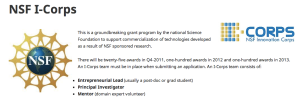I have been following the NSF I-Corps experiment since its inception and have  been pleasantly surprised by its growth and expanding reach. GWU, University of Maryland and Virginia Tech have taken the lead in our region (the DC I-Corps) and have some great people working on the program. I came across a piece from Stephanie Baum at Med City News highlighting some of the innovative teams and projects taking part. From Baum,
been pleasantly surprised by its growth and expanding reach. GWU, University of Maryland and Virginia Tech have taken the lead in our region (the DC I-Corps) and have some great people working on the program. I came across a piece from Stephanie Baum at Med City News highlighting some of the innovative teams and projects taking part. From Baum,
Here’s a sample of the healthcare and device technologies involved in the program, which runs through November 19.
University of Maryland, College Park
Myotherapeutics is developing a clinical assay for Amyotrophic Lateral Sclerosis or Lou Gehrig’s disease. Eva Chin, an assistant professor, leads the group.
George Washington University
Key Orthopedics has a 3D-printed polymer device for growing stem cells in bone and cartilage tissue and is led by Benjamin Holmes, a Ph.D student.
NanoChon is producing joint injury therapeutic technologies for extended and sustained biologic delivery. It’s led by Nathan Castro, a Ph.D. student.
Its exciting to see our local universities, their leaders, faculty, and graduate students learning to employ lean in the development of their ideas and technologies. Exciting time.
